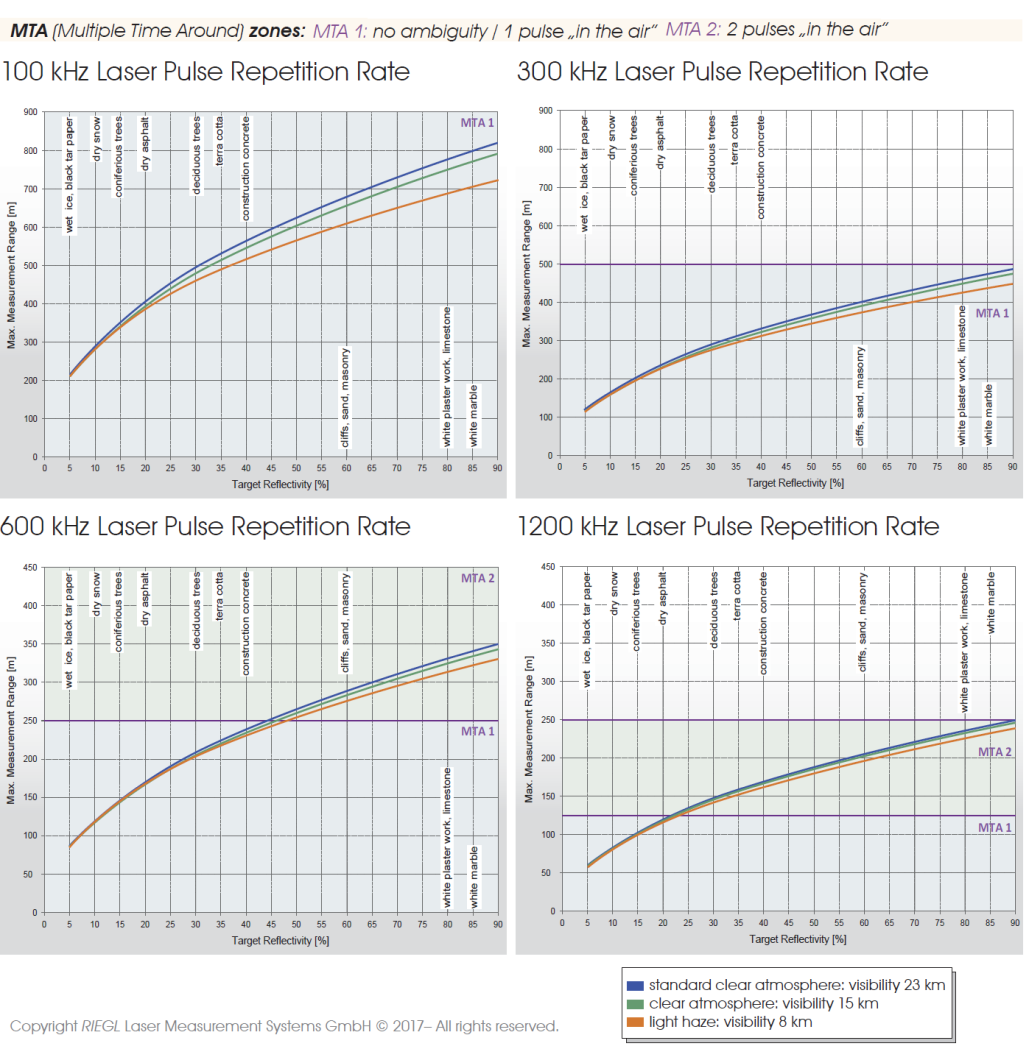Laser Scanning - RIEGL VZ-400i (UTC) - 20
Description
Driver to control and decode the real-time data-stream from a RIEGL VZ-400i, an ultra high performance 3D terrestrial laser scanner.
Driver Information
| Driver | RIEGL VZ-400i | Interface Type | Freebase/TCP/IP/UDP | Driver Class Type | Freebase |
|---|---|---|---|---|---|
| UTC Driver | Yes | Input / Output | Input/Output | Executable | DrvLaser.exe RIEGL_VZ400i |
| Related Systems |
| ||||
| Related Pages | |||||
Decoding Notes
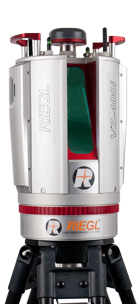
- Laser class 1 is used which is eye-safe.
- Hardly any reflections from a water surface will be received, which makes a VZ scanner ideal for combining with multibeam data acquisition surveys.
- The driver can use this scanner in so-called profiler (2D) or in radar (3D) mode.
- The actual raw binary data stream is in so-called RXP format: a proprietary data format defined by RIEGL which is not described in this manual.
- The theoretical maximum expected points/seconds depends on the selected scan rate. The actual decoded points depend further on other user-definable settings, like a range mask, a vertical area mask, etc.
For more information about these settings see the Qinsy Online Setup. - Next to each point x,y,z value, three other important attributes are stored, dealing with the reflection from the target's surface:
- Echo return type
The echo return type indicates whether the returned signal is a single, a first, an interior or a last echo from the same emitted pulse.
This means that one pulse may return multiple beams (pixels). For example the first return from a tree-leaf, an interior return type from another leaf, and a last return type from a wall behind the tree.
In Qinsy the echo return type is stored as the Detection ID. - Amplitude
The value of the pixel amplitude (returned power) is situation dependent and its range will be between 0 and 80 dB.
In Qinsy the amplitude value is stored as Quality. - Reflection
More important and more usable is the reflectance, a kind of 'normalized' amplitude, which will always be in the range of -25 dB to 65 dB.
It is the received power relative to the power that would be received from a white diffuse target (0 dB) at the same distance. The surface normal of this target is assumed to be parallel to the laser beam direction.
In Qinsy the reflection is stored as Intensity.
If setting 'Modify Intensity Echo types' is enabled (see Qinsy Online tab), it will be the reflectance plus 1000 in case of a last echo return type, and reflectance minus 1000 in case of an interior echo return type.
For first and single echo types it will be the exact value as reported by the scanner.
The Quality or Intensity value can be used for color-coding, e.g. when viewing the final point cloud in the Validator.
- Echo return type
Interfacing Notes
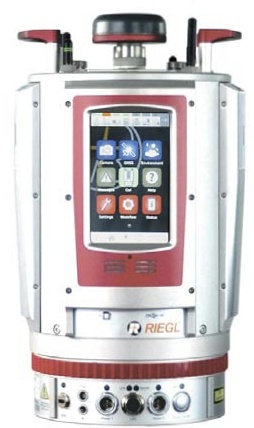
Most control of the scanner can be done using the Controller while online, like start/stop scanning, defining the scan rate/resolution, etc.
Check the Qinsy Online tab section for all the details about this.
However for some additional information or status overview you should use the touch screen display on the scanner itself (man-machine-interface menu).
Alternatively you can remotely control this scanner's menu by using the dedicated RIEGL VZ-i Series App (download using this link) or by using a free VNC Client/Viewer.
IP Address
Go to the LAN Status menu to get the IP Address of the scanner.
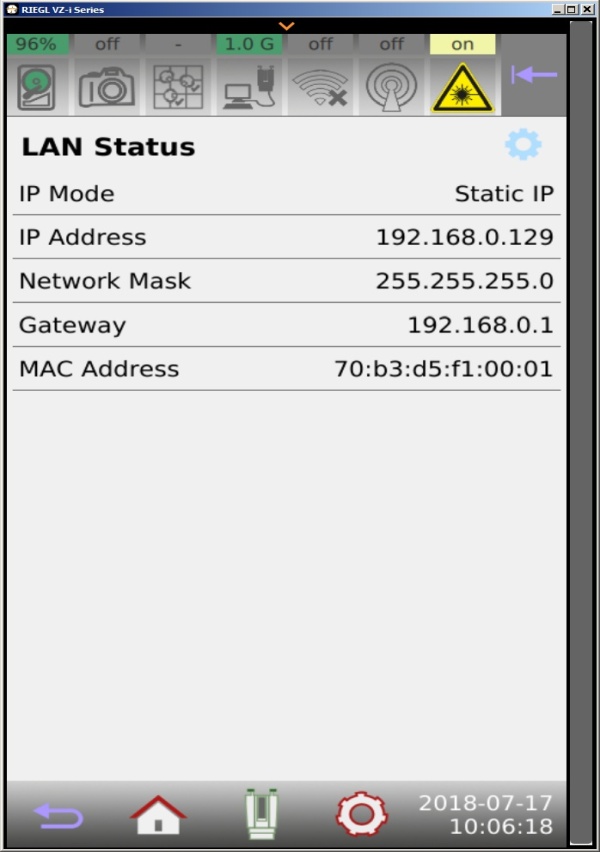
This address needs to be entered in the template database setup.
See also the Network section for more information.
GNSS/Time synchronization
Go to the GNSS status menu to check whether satellites are received and if the Time Synchronization status is 'Synced'.
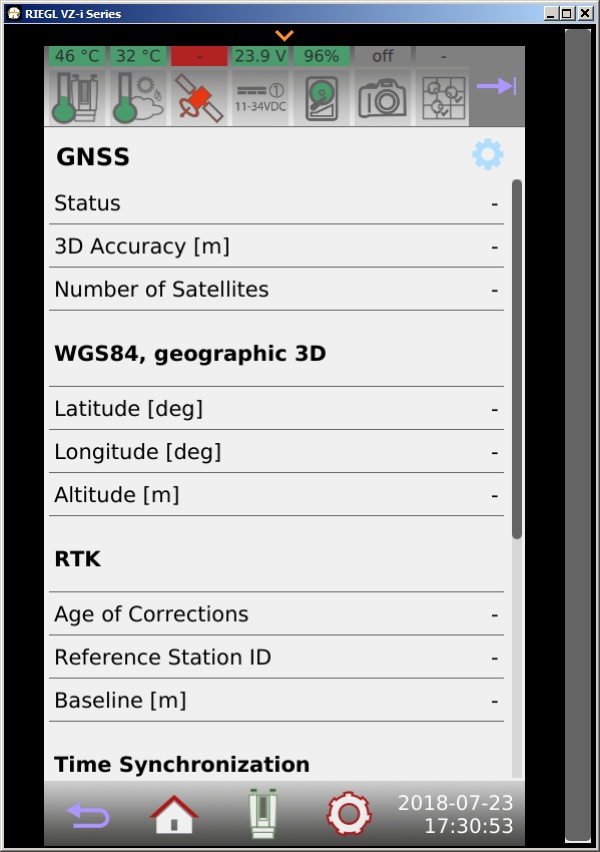
In the above example no valid GNSS is detected and therefore no accurate timing is possible.
See also the 41309600 for more information.
If you don't know the scanner's IP Address see the MMI section on how to get this address
Communication with the scanner always goes via TCP network.
It is advisable to use a fast (Gigabit) network card, due to the enormous amount of data to be expected.
Use the dedicated green TCP/IP cable (M12-RJ45) to connect the scanner with the Qinsy computer.
In case your computer's network card sub-net IP address differs from the scanner's IP address and you can not change the address of your computer's network card (e.g. other network devices are also connected), it is possible to change the default IP address of the scanner.
Please consult the laser scanner manual or contact RIEGL support on how to do this.
It is a good practice to use the Ping command from the Windows Command Prompt in order to check for a successful network connection between Qinsy and the scanner:
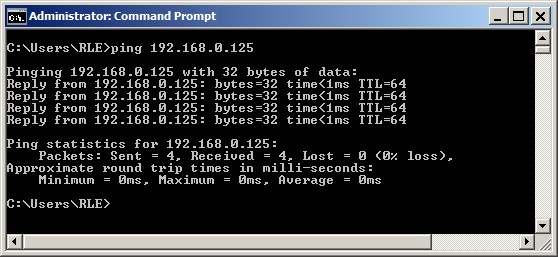
If you can't ping the scanner's address successfully, it is no use to continue: first a valid network connection must be established between scanner and Qinsy computer.
Every time you go online you must make a connection manually. This ensures that communication with the scanner is okay or not.
However, as an advanced user you can let the driver automatically connect every time you come online:
Use a registry editor and change the value from 0 into 1 for the following registry key:
HKEY_CURRENT_USER\Software\QPS\Qinsy\8.0\Drivers\DrvLaser\Settings\AutoConnect
Use this advanced option only when you are sure that the network is okay between scanner and Qinsy computer, because if the connection fails you will experience a longer timeout before the Controller is ready.
General
Without time-synchronization the driver will time-stamp the data when received at the network port.
However, due to network characteristics in general this may result in inaccurate timing, especially when you are scanning from a moving platform (vessel or car).
Therefore timing via Time Synchronization pulse (PPS) from a GNSS system is mandatory: for this it is perfect to use the scanner's own internal GNSS.
Alternatively you may use an external GNSS/PPS connected to the Trig Socket port, but for the sake of simplicity (no extra cables are needed) you should use the internal one.
Notice that for the integrity and accuracy of the time-stamping it does not matter which GNSS system you use, external or internal.
Check
Always use the man-machine-interface GNSS menu (as displayed on the right) to check if the scanner does receive satellite signals:
Notice that the position itself is not being used, therefore its accuracy is not important.
But at least 1 satellite should be received.
More important is the status of the Time Synchronization:
This should be Synced and the Time (representing UTC time in day seconds) should increment nicely every second.
Please refer to the Qinsy Online pane information about monitoring the time synchronization status while scanning.
Alternative scenario
If you select in your template setup the driver "Laser Scanning - RIEGL VZ-400i" (so without "(With UTC)" in the driver's name) then this will disable the use of the GNSS on the scanner when coming online.
Therefore the time from the message is not used and data will be time stamped when received at the network port.
Some scenarios may justify the use of the driver without accurate timing:
- During testing inside a building (no GNSS signal available)
- During mobilization without having all equipment ready yet
- When using the scanner fixed on a tripod (so not on a moving platform)
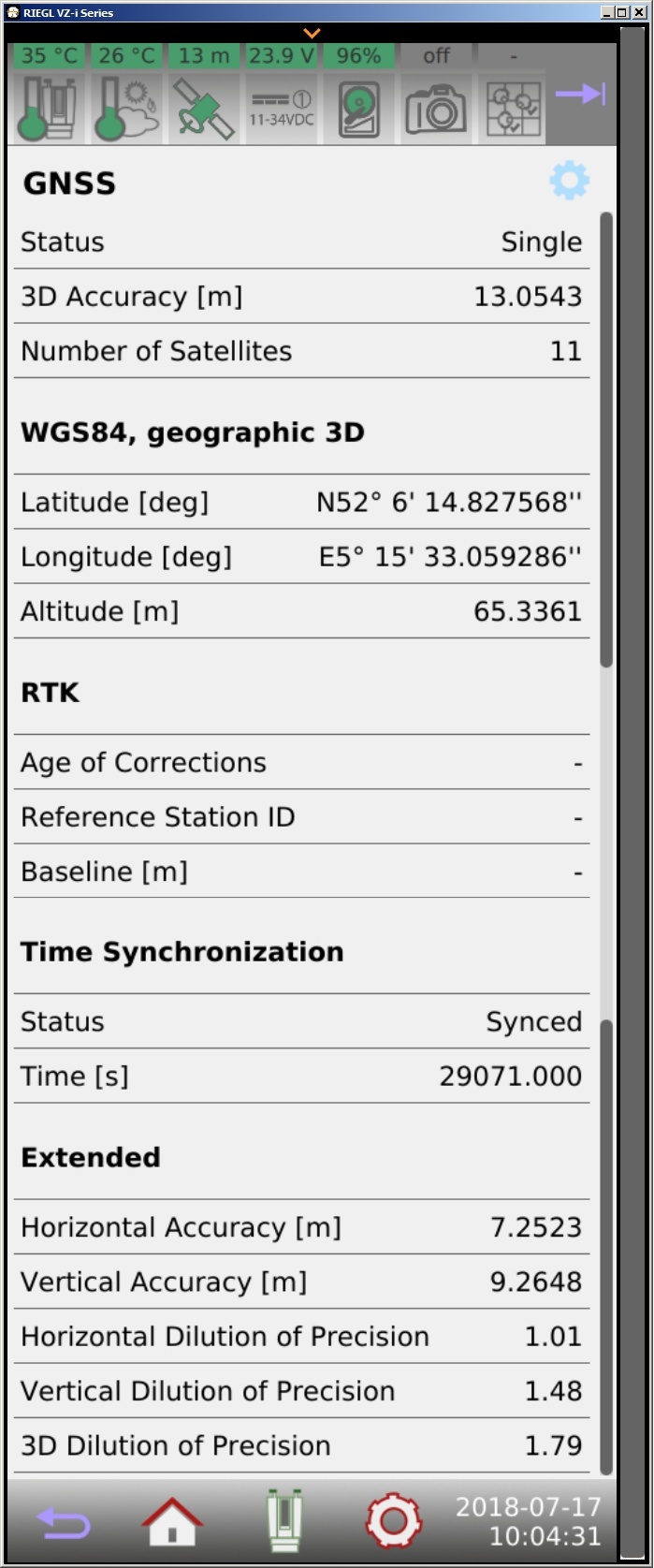
Database Setup
Internally the driver is treated as a multibeam system creating multibeam 'XYZ' observations, therefore you will find the laser system drivers under category type Multibeam Echosounders.
Terminology 'Multibeam' versus 'Laser scanning': ping = scan, swath = profile = line, footprint = pixel = pulse = return
1. Edit System Wizard
Add a Multibeam Echosounder system to your Template Setup, and select the correct driver "Laser Scanning - RIEGL VZ-400i (With UTC)".
The Port number must be the same as the configuration port of the scanner, normally 20002. The driver will communicate (sending and receiving commands) via this configuration port of the scanner.
The real-time line-stream is received via the data port, and is always the configuration port number minus one, so normally 20001. You don't have to enter this data port number in the setup.
It is important to enter for the IP Address the address of the scanner, by default this will be something like 192.168.0.xxx.
If you don't know the scanner's IP Address see the System Interfacing 41309600 section on how to get this address
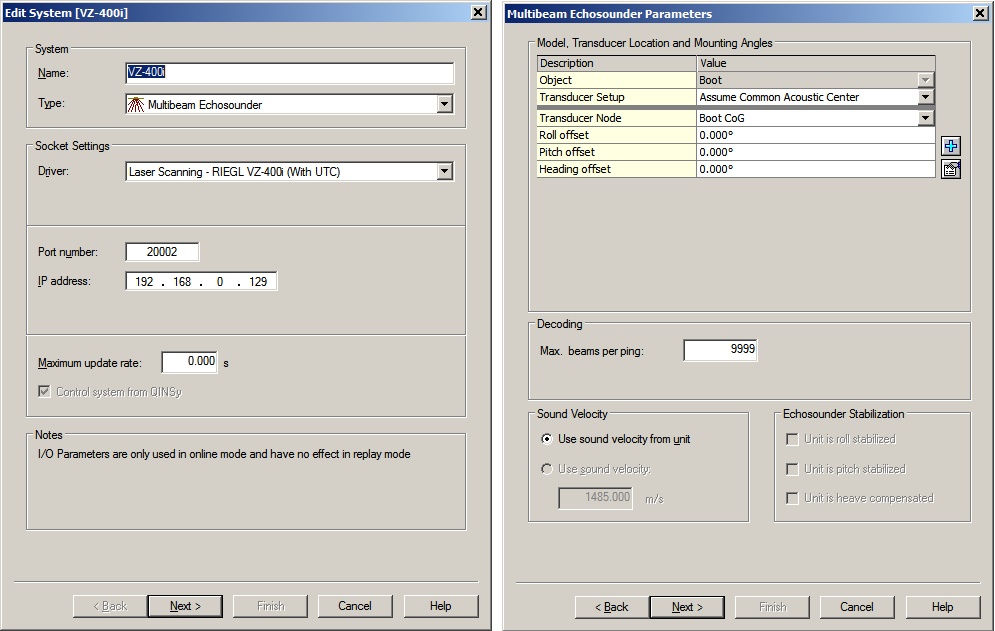
It is recommended to have a dedicated network interface between your computer and the scanner.
In case your computer's network card sub-net IP address differs from the scanner's IP address and you can not change the address of your computer's network card (e.g. other network devices are also connected), it is possible to change the default IP address of the scanner.
Please consult the laser scanner manual or contact RIEGL support on how to do this.
The maximum update rate is not used, so leave it at zero.
2. Multibeam Echosounder Parameters
On the second page the Transducer Location and Mounting Angles are important.
Before such a calibration please use values as accurate as possible, e.g. when the connectors of the scanner are pointing in a certain direction use the following table as guidance:
| Connectors of the scanner pointing | Heading offset |
|---|---|
| Forward (bow) | 0º |
| Right (starboard side) | 90º |
| Backwards (aft) | 180º |
| Left (port side) | 270º |
The exact values for the roll, pitch and heading offsets should be established with a calibration procedure
Further note that the scanner's own co-ordinate system (RIEGL convention) differs from the Qinsy XYZ system: the driver will automatically convert the SOCS to Qinsy co-ordinate system.
| Scanner's Own Co-ordinate System (SOCS) | Qinsy | ||
|---|---|---|---|
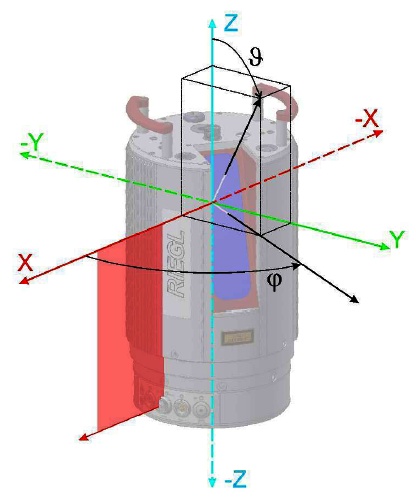 | -Y | → | X |
+X | → | Y | |
-Z | → | Z | |
Leave the Max. beams per Ping value to 9999. The actual number of beams will be variable and depends for example on the settings used on-line, and on the targets being scanned.
3. Next Pages
Leave all other values on the next page(s) also at their defaults.
Check List
Please use at least the following checks prior start scanning and recording laser data:
- Is there a valid network connection between the scanner and the Qinsy computer?
- Is the GNSS and/or PPS timing okay at the scanner?
- After starting scanning, do you see a low Ping Age, using a Generic Display?
Online
When on-line, the laser unit can be controlled using the Controller:
Select Echosounder Settings, click on the Laser System icon, and select the 'Control' tab page.
First of all: every-time when you come on-line a (TCP/IP) network connection has to be established between Qinsy and the laser unit.
Set option 'Connected' to Yes and select the Apply button.
Please wait until you see in the Events list that a connection has been made successfully.

Connected | Select Yes to connect (using TCP/IP) to the so-called LRC Server of the Laser Scanner. Under normal circumstances a successful connection will be established within a second. The driver will automatically disconnect when going offline, but you may also do this manually prior quitting. Notice the long timeout when no network connection can be made: it may take up to 20 seconds before you can continue. This may happen for example when the laser unit is still switched off or when the used IP address is not correct. After this timeout you will be informed in the Events list with a possible reason. So if it takes considerable more time, please check your network cable/setup/configuration. See the 41309600 section under System Interfacing for more information about this. |
Action | Selected action will be sent to the laser unit, immediately after hitting the Apply or OK button. You must be connected first in order to select an action. Notice that any selection will always revert back to [ None ], after each selected action. It is recommended to wait a few moments after each action, until the status in the Events list is updated with a message, because it takes some time for the unit to handle each command (action).
|
Scan Mode | Select the required measurement method: Line (2D), i.e. looking at one fixed direction, or Radar (3D), i.e. scanning 360° around. |
Scan Direction | Set the line scan direction in degrees. Valid values are from 0° to 360°. Use the scanner's own co-ordinate system (SOCS): 0° means forward, 90° means left, 180° looking backward and 270° means looking right. Forward here means the same direction as the connectors on the scanner device. This option is only available when Scan Mode is set to Line (2D). |
Continuous | When enabled, scanner will start endless scanning after [Start], until the [Stop] command is received. This option is only available when Scan Mode is set to Radar (3D). |
Lines | The maximum number of lines to scan after the [Start] command is received. This parameter is not used when the above mentioned option Continuous scanning is enabled. |
Horizontal Area Selection | The horizontal scan area goes from 0 to 720°. Using the scanner's own co-ordinate system (SOCS), 0° means forward, 90° means left, 180° looking backward and 270° means looking right. (Forward here means the same direction as the connectors on the scanner device). This option is only available when Scan Mode is set to Radar (3D). Select the required scheme from the list. Schemes are defined in the Laser Device Settings XML File. Excluded data due to this setting will not be recorded. |
Vertical Area Selection | Using the scanner's own co-ordinate system (SOCS), 0° means looking up, 90° means looking horizontal and 180° means looking down. For this scanner the maximum vertical scan area (FOV) yields 100°, so it goes from 30° (up) to 130° (down). 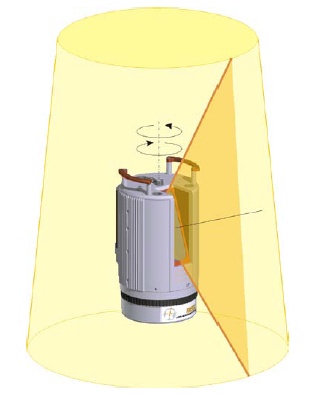 Schemes are defined in the Laser Device Settings XML File. Select the required scheme from the list:
Excluded data due to this setting will not be recorded. |
Sector Reduction | Select the required scheme from the list. Schemes are defined in the Laser Device Settings XML File. |
Scan Rate | Select the required scanner measurement rate (i.e. maximum number of pixels / second)
Be careful when using the last two scan rates (which are not MTA safe) when scanning objects not close by: - Use 600 kHz only in an environment with no possible objects at 250 meter distance or further. Possible objects scanned at more than that distance will appear much closer in your final DTM point cloud due to ambiguity. See the 41309600 under Additional Information for more about Multiple Time Around. |
Scan Resolution | Select the required vertical angle resolution (i.e. the angle increment between two consecutive pixels)
Use the following table to see what the results will be for all the possible Scan Rate / Scan Resolution combinations:  |
Minimum Range | Set the minimum required range in meters. Valid Values: 0.5 to 800 meters. Using this setting is recommended, but be careful: Blocked data due to this setting (i.e. all pixels less than this range) will not be recorded! |
Maximum Range | Set the maximum allowed range in meters. Valid Values: 0.5 to 800 meters. Using this setting is recommended, but be careful: Blocked data due to this setting (i.e. all pixels more than this range) will not be recorded! |
Minimum Amplitude | Set the minimum required amplitude (returned power in dB) value. Values are scanner dependent, and normally in the range between 0 and 80 dB. Notice that blocked data due to this setting will not be recorded. This option may not be available in your setup. In that case all amplitude values will be accepted. |
Maximum Amplitude | Set the maximum allowed amplitude (in dB) value. Values are scanner dependent, and normally in the range between 0 to 80 dB. Notice that blocked data due to this setting will not be recorded. This option may not be available in your setup. In that case all amplitude values will be accepted. |
Minimum Reflection | Set the minimum required reflection (in dB). The reflection is a 'normalized' amplitude, and values are in the range between -25 dB to 65 dB. It is the received power relative to the power that would be received from a white diffuse target (0 dB) at the same distance. The surface normal of this target is assumed to be parallel to the laser beam direction. Notice that blocked data due to this setting will not be recorded. This option may not be available in your setup. In that case all reflection values will be accepted. |
Maximum Reflection | Set the maximum allowed reflection (in dB). The reflection is a 'normalized' amplitude, and values are in the range between -25 dB to 65 dB. It is the received power relative to the power that would be received from a white diffuse target (0 dB) at the same distance. The surface normal of this target is assumed to be parallel to the laser beam direction. Notice that blocked data due to this setting will not be recorded. This option may not be available in your setup. In that case all reflection values will be accepted. |
Atmospheric Relative Humidity | Set the current atmospheric relative humidity. Valid values: 0% - 100%. Atmospheric parameters are needed when highly accurate range measurements are required. This option may not be available in your setup. In that case the default value will be used. |
Atmospheric Temperature | Set the current atmospheric temperature in degrees Celsius. Valid values: -50°C - 100°C. Atmospheric parameters are needed when highly accurate range measurements are required. This option may not be available in your setup. In that case the default value will be used. |
Atmospheric Pressure at Sealevel | Set the atmospheric pressure at sea level in mbar. Valid values: 0 - 1200 mbar. Atmospheric parameters are needed when highly accurate range measurements are required. This option may not be available in your setup. In that case the default value will be used. |
Height above Mean Sealevel | Set the height above mean sea level in meters. Valid values: 0 m - 1000 m. Atmospheric parameters are needed when highly accurate range measurements are required. This option may not be available in your setup. In that case the default value will be used. |
Multi Target Measurement | One emitted laser pulse may hit one or several targets, causing one or several echo pulses. For example the first return is from a tree-leaf, an interior return type comes from another leaf, and a possible last return type because of hitting the wall. Select here the type of echo pulse you want to decode. Notice that blocked data due to this setting will not be recorded. |
Modify Intensity Echo types | When enabled, the original reported reflection (intensity) value for interior and last echo types will be modified. Notice that the intensity value for first and single echo types are never modified. See also the echo type explanation in the 41309600 section |
Store Laser Location | If enabled, an additional pixel with zero co-ordinates will be added to each line scan, in order to indicate the exact laser scanner location in the resulting point cloud. This extra pixel will always have beam number 1, and its intensity/quality value will be zero. |
Use PPS (Time Synchronization) | Notice that this setting is only available when laser driver '...(With UTC)' has been selected in your template setup. The most convenient setup is to use the Time Synchronization from the Internal GPS. In case you use Time Synchronization from an external GNSS, the scanner needs a valid NMEA GGA message and Time Synchronization pulse from your GNSS receiver. The exact I/O parameters from this external GNSS need to be defined using the following settings below: |
PPS Trigger Edge | Select the used trigger edge of the external GNSS PPS pulse. It depends on the external GNSS receiver being used and you should therefore consult the receiver manual. |
GPS Baudrate | Select the baud rate of the external GNSS receiver connected to the scanner This setting is only available when using Time Synchronization from an External GPS. |
GPS Format | Select the format of the external GPS message connected to the scanner: This setting is only available when using Time Synchronization from an External GPS.
|
PPS Pulse/Data Sequence | Select if the external Time Synchronization pulse comes before the GPS data string, or vice versa. |
| Validation Check | When changing settings, the theoretically expected points/sec will be calculated, which should not exceed the recommended maximum points/sec. The expected points/sec depends on the selected Scan Rate, the Vertical Area Selection and a possible Sector Reduction selection. Qinsy handles only approximately 250 thousand measurements per second. However, this value can be safely much higher but depends highly on the used hardware. Nevertheless it is important to prepare the project prior to the start of the scanning by optimizing all parameters to meet the necessary requirements: An advanced user may overrule this limitation of max 250 thousand points per sec: Disable the Validation Check in order to ignore the warning and continue. |
| Session Storage Format Specifier | This format specifier can be used in combination with the Controller Session Storage Format Specifier #E. The following specifiers are supported (plus your own free text): #A: Scan Mode The format specifiers are case-sensitive. If you use lower-case then only a value or index number will be displayed. So if you use #E in the Session Storage Setup the filename of the new recorded databases will automatically contain the scanner settings that you were using. Example:  |
Generic Display

Use this display to check two important values:
- Ping Age
The ping age value (in seconds) must be around zero (e.g. 0.01 or 0.005). - Status Flag
Make sure that the status flag value is 2, meaning 'PPS OKAY'.
If the Status Flag is 0 then this either means that: - you are using driver "Laser Scanning - RIEGL VZ-400i" without "(With UTC)" (not recommended), or
- your template setup has no Time Synchronization system defined (not recommended), or
- your Qinsy Time Synchronization system is not working (please check), or
- the Time Synchronization status on the 41309600 is not 'Sync', or
- the internal reported GPS_STATUS from the RIEGL data stream is not 0x3.
You may use the attached example Generic Display Layout file as example:
Download the file using the link (for this you need Internet access), copy the layout (Use 'Save Link As...') to your current Project's Settings\Display folder and open it using a new Generic Display.
You only have to select the correct laser system as defined in your template setup.
Raw Multibeam Display
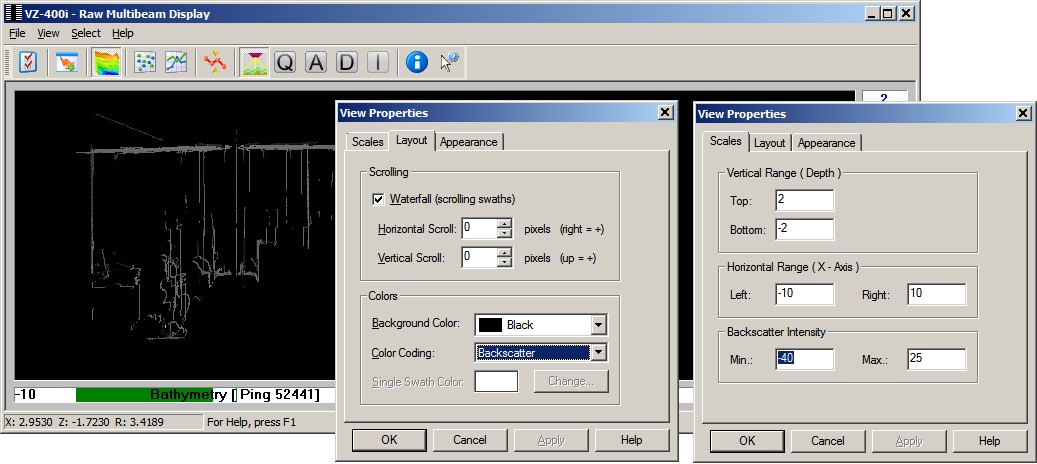
Laser data in a Raw Multibeam Display is uncorrected for motion, but it will give you a good indication whether laser data is decoded or not and what kind of objects are detected.
If you set Color Coding to Backscatter then the intensity (reported reflection) will be used for color coding.
Adjust the Backscatter Intensity scale, so set the minimum and maximum values to something like -40 to +40.
Additional Information
If you experience problems using your laser scanner in combination with this driver or if you need additional information or support then please attach the daily laser log-file when submitting your JIRA support ticket.
At the bottom of this section you'll find the information on where to find this daily laser log file
Network Problems
Windows Firewall
A commonly reported problem is that network data is blocked by the Windows Firewall.
When this happens you may see that data does come in using other utilities (like the I/O Tester or the manufacturer's own software), but that the Qinsy driver does not accept any data.
The following (Windows 10) steps may solve this:
Go offline, open the PC Settings (Start menu, Settings)
Select Windows Firewall (Update & Security, Windows Security, Firewall & network protection)
Select Advanced settings
Select Inbound Rules, highlight all 'Driver for Laser Scanning' entries and delete them using the right mouse popup menu (or Del key)
If you now go online, the Windows Security Alert message will pop up: It is important to tick all three check boxes!
Multiple Network Cards
Another possible problem could be that your computer has more than one network card installed (e.g. LAN and WIFI), but within the same sub-net mask range (255.255.255.0).
It is recommended to make the first three digits unique for each network card IP address.
You may check the daily laser log-file; it will show the IP addresses for all available network adapters and indicates which one the driver will use:

Please check that the driver is using the correct one!
Missing Data
If you occasionally experience gaps in your data, this may be caused by a general Windows setting that affects the data throughput of your network card.
Change the following registry key: HKEY_LOCAL_MACHINE\SOFTWARE\Microsoft\Windows NT\CurrentVersion\Multimedia\SystemProfile\NetworkThrottlingIndex
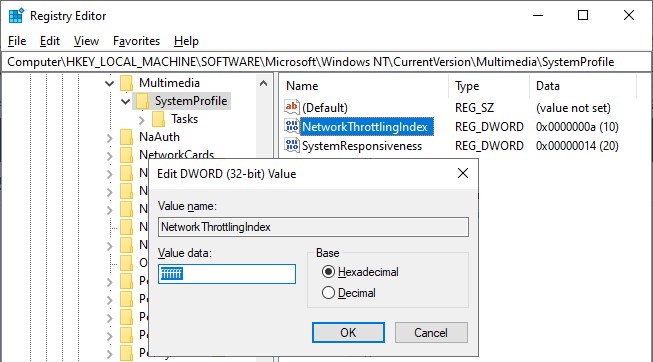
Set the new value to ffffffff (which will tell Windows to disable network throttling) and restart the computer.
Note that disabling network throttling may affect playing multimedia on your computer, but for laser scanning operations it is advisable to have a maximum data throughput of your network.
Daily Laser Log File
All user actions, system information and reported errors are logged in a daily laser log file which can be found in the current project's LogFiles subfolder.
The filename convention for this ASCII log-file is <System Name> DD-MM-YYYY.log, so every day there will be a new one.
Note that all time stamps in this log file are by default in UTC. An advanced user may change this to local time zone (LTZ) by changing the registry key:
HKEY_CURRENT_USER\Software\QPS\QINSy\8.0\Drivers\DrvLaser\Settings\TimeLogFileUtc value from 1 to 0.
Improve Performance
Due to the enormous amount of data to be expected while scanning and recording, it is recommended to keep the system overhead as low as possible.
Here you'll find some tips and tricks in order to fine-tune your setup.
However, these are not strict rules, because each project is different and depends on the current situation and hardware being used. Your goal should be to keep your system CPU usage as low as possible.
HARDWARE
Storage
Make use of Solid State Drive (SSD), or fast SATA hard drive (7200 - 10000 rpm).
Network
Your network card speed should never be lower than the scanner's network speed. Use a network card that can be configured for 100Mbit or 1Gbit speed. Do not use USB Networking Adapters, because this may result in loss of data when huge amounts of data are being broadcast.
Virus Scanner
Disable Virus Scanner or at least the setting 'Scan Files when Writing/Reading to/from disk'.
Task Manager CPU
General Task Manager CPU Usage should be less than 50%. CPU load of each display must be less than 10-15%.
Make sure that the 'Working Set (Memory)' column for process Multibeamer.exe and/or DrvResultOut.exe is not constantly increasing, especially during recording. For detailed information about this see the section Real-time Performance Monitoring below.
PROJECT PREPARATION
Controller Laser Device Settings
During project preparation, establish the optimum settings in order to achieve the required results.
The most benefit you will gain from setting the Min/Max Range limits, Scan Speed, Scan Rate, Scan Resolution, Angle Resolution, Vertical Area Selection, Scan Area Selection and Sector Reduction as well as possible.
Especially the Vertical or Scan Area Selection is very important. Make use of Mask schemes to define areas which you don't want to scan.
ONLINE
Raw Multibeam Display
Open only one Raw Multibeam Display and more important: do not use the options 'Show Big Dots' or 'Draw Lines'.
Navigation Display
Open only one Navigation Display.
Preferably disable DXF and TIFF layers or other big background files. Note that these layers should only be used during project preparation.
When 'object tracking' is enabled, do not zoom in too close. Keep in mind that the display should not be 'refreshed' more than 1x per second.
3D Point Cloud Display
It is not recommended to use a 3D Point Cloud Display, unless your hardware contains a high-spec video card.
Under Sensor settings set the Time window setting to a short period, e.g. 10 sec
Sounding Grid / Dynamic Surface
Storage to a grid is not recommended and should be purely for display purposes: e.g. for checking the scan coverage or for showing the 95% Confidence Level statistics.
If you do want to see the scan coverage then it is advisable to store to a sounding grid and not to the dynamic surface
Do not use a small cell-size; preferably not less than 1.0 meter.
If you notice in the Navigation Display that the real-time sounding grid is updated with a delay then please increase the cell-size or disable the storage completely.
Note that in Replay (offline) there are no limitations and you may use small cell-sizes, e.g. 0.10 meter.
OFFLINE
Replay
In Replay there are no limitations as mentioned above: use as many displays as you like, store to sounding grids with small cell-sizes, update the dynamic surface, etc.
All this may only affect the replay speed, but the data integrity of your final DTM processing files should be fine.
COMPUTATION SETUP
While working online, disabling the laser system in your Computation Setup will have the most effect on the performance
The final footprints will not be geo-referenced, nor corrected for motion, heading or timing in real-time, which will save a tremendous amount of CPU power and memory usage.
This tip allows you to get the most out of your scanner: maximum scanning speed and maximum scanning rate, without the risk of losing scans due to performance issues.
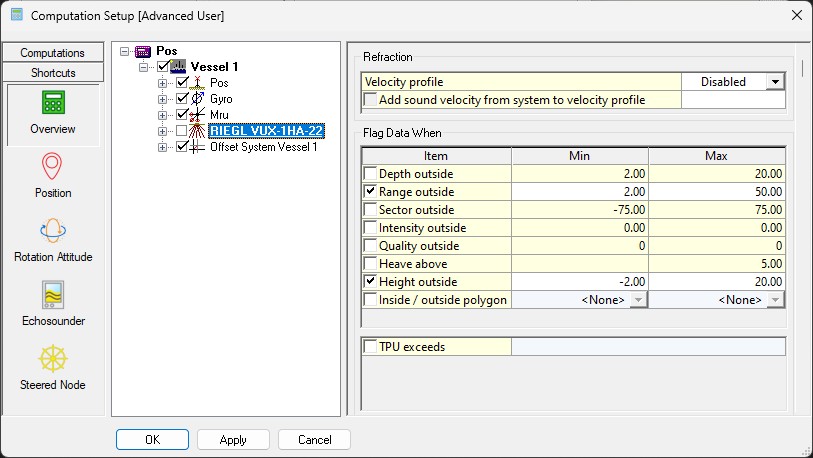
Drawback is that no DTM file (e.g. QPD) is created, nor a sounding grid is filled, while working online.
In order to create a final DTM and/or Sounding Grid file you just need to Replay the recorded databases afterwards.
Online you can choose between four available scan rates.
- 100 kHz (42K pts/sec) - MTA safe
- 300 kHz (125K pts/sec) - MTA safe
- 600 kHz (250K pts/sec)
- 1200 kHz (500K pts/sec)
The selection affects the maximum number of points expected per second.
The first two scan rates are MTA safe which means ambiguity is not possible: only 1 pulse is in the air.
Be careful when using the last two scan rates, which are not MTA safe, when scanning objects not close by:
- Use 600 kHz only in an environment with no possible objects at 250 meter distance or further.
- Use 1200 kHz only in an environment with no possible objects at 125 meter distance or further.
Possible objects scanned at more than that distance will appear much closer in your final DTM point cloud due to ambiguity.
